Sun's W2100z Dual Opteron Workstation
by Kristopher Kubicki on October 27, 2004 12:05 AM EST- Posted in
- Systems
Thermals, Noise
Sonic
Having spent a considerable amount of time working on high end workstations in the past, the nagging thermal and audible "gotchas" are not issues to overlook. Many workstations perform outstanding when compared to an equivalent desktop setup, but they sound like a helicopter taking off. As we mentioned previously in the analysis, we were impressed by the simplicity and elegance of the w2100z internals. The true test of their worth seems to be when we start up the system and actually start using it. When we first set up our w2100z and the machine POST for the first time, we were greeted by the 120mm fan running at full speed, well above 50dBA! Fortunately, the initial fan speed setting seemed to only be part of the initial self-diagnostic test, and we never hear the fan peak over 30dBA for the rest of the analysis.Above, you can see the sole source of the w2100z's exhaust. If you look really closely at the EMI shield, you can see where the PS/2 ports are covered up still.
By contrast, our whitebox server setup is almost always running at or above 50dBA. The form factor is considerably different and the machine is more accustomed to sitting in a rack than on our desk. The comparison is apples to oranges, but our w2100z never makes the same amount of noise as our whitebox configuration.
Thermal
Equally important to any audible testing is a thermal analysis. We should approach any thermal testing in the same manner that one would approach any other enclosure review. In our previous enclosure analyses, we generally prefer bigger, slower moving fans over smaller, faster ones. It has been scientifically proven that when two sounds of equal dBA are compared side by side, humans tend to perceive the one with a higher pitch as "louder". Based on this premise, and the premise that larger fans move air over a larger area than smaller ones, Sun's layout for their exhaust makes a lot of sense. During our review, we did not see the fan peak over 2500 RPM, and generally, it averaged around 1100 RPM. 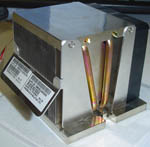 |
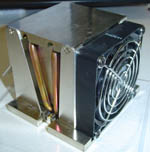 |
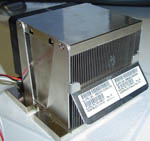 |
| Click to enlarge. | ||
Sun's heatsink/fan (HSF) combos are made almost entirely of aluminum, but unique because they employ a side fan and a system of heat pipes. Lately, every third-party manufacturer seems to have some heat pipes in their CPU coolers, so we weren't particularly surprised that they were adopted in the w2100z as well. The heatsinks play an integral role in Sun's very carefully designed thermal footprint - they are both placed in line with the 120mm exhaust and the second heatsink has fins to vortex hot air into the path of the 120mm fan. These small, professional attentions to detail compose part of our good impression confirming Sun's ability as a premiere workstation designer.
We added some other test points for this review to provide everyone with some thermal cross sections. The first graph shows the ambient air temperature taken from a sensor attached just off the inner wall of the side panel. You may download the CSV worksheet with each individual location tested here (under load). All positions on the graph below are measured using a digital thermometer with remote sensors at a constant ambient temperature of 22.3 degrees Celsius. After 30 minutes of looping SpecViewperf 8, we measured our workstation.
You can see that the warmest ambient air resides near the bottom of the case. As we expected, there are pockets of warm air grouping around the video card and hard drive where we have no active cooling moving air around. Most importantly, the AGP, PCI-X and SCSI tunnels are operating at significantly high temperatures and contributing to this warm air pocket. You can see the graph below, which denotes various surface temperatures of some of the components in the system. Hovering over the image reveals the temperatures of the CPU mezzanine as well.
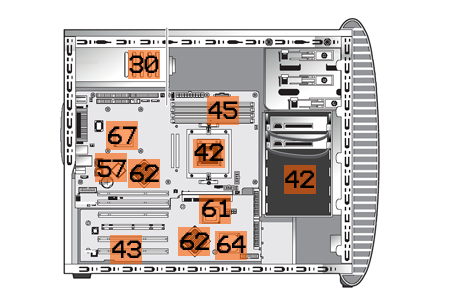
Hold your mouse over for the Overlay.
The CPUs themselves were both measured at 52 degrees Celsius under load, certainly not poor results. There is definitely a correlation between the surface temperatures of some of our components and the ambient air graph that we already saw. Temperatures on the SCSI controller and PCI tunnels are a little high and all of these components are passively cooled. Obviously, the components under the CPU mezzanine register as very warm, since they are not getting the benefits of the exhaust fan.
While testing the thermal components of the system, every time we removed the side panel, our rear exhaust fan shot up several hundred RPMs. Without the negative pressure pull across the inside of the case, the system almost immediately detects increased heat.


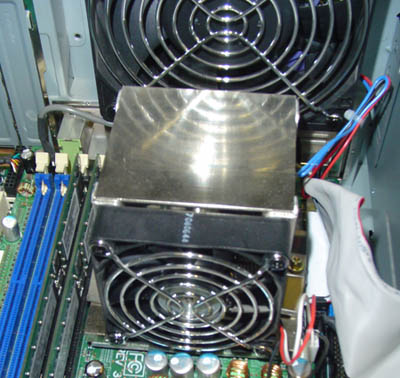
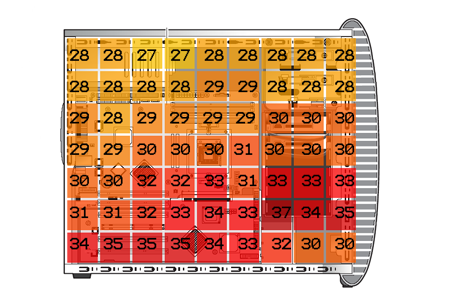








47 Comments
View All Comments
KristopherKubicki - Wednesday, October 27, 2004 - link
PrinceGaz: Multiple probes.Thanks for all the positive feedback!
Kristopher
slashbinslashbash - Wednesday, October 27, 2004 - link
#12, the Power Mac G5 is Apple's high-end workstation/server. The iMac is Apple's consumer-oriented product.I'd say that the PPC970 (G5) should be roughly comparable to an Opteron/Athlon64 at the same speeds -- at least much more comparable than a P4 at the same clock speeds. It's got a 16-stage integer pipeline, and the FPU units kick serious ass, especially with code that utilizes AltiVec (similar to SSE for x86). It's got a high-speed bus comparable to HyperTransport. AMD's integrated memory controller does give an advantage, but still I think the G5 could hang in there. Really though, any benchmark would come down to optimized code. Companies like Adobe and Apple that have the time, money, and inclination to optimize their applications for Apple hardware will see serious performance advantages over PC hardware. gcc-compiled apps, not so much, although more PPC-specific optimizations should come sooner or later.
Arstechnica has a very lengthy article on the PPC970 architecture. Take a look, if you have the time, and I don't think you'll walk away with a bad opinion of the G5.
BTW, I'm glad to see a Sun review here :) Interesting stuff. I would've liked to see another shot or two of the case itself, with all the components in it; plus a shot from the rear of the system. I'd like to see just how much space is in between that mezzanine card and the motherboard, and I'm kind of confused as to how the extender card fits in. It looks like it simply lies parallel with the motherboard (attaching along the bottom of the motherboard), but most of the time that there's a separate card, it is perpindicular.
thesix - Wednesday, October 27, 2004 - link
#12:"mlittl3 is attempting to compare a consumer product with a high end workstation/server."
You talk like a typical marketing person.
From pure HW design/layout point of view,
G5 _feels_ so much better than w2100z.
What makes me feel better with w2100z is the (new) Solairs OS and Opteron CPU.
Plus, I want to show support for both Sun and AMD :)
thesix - Wednesday, October 27, 2004 - link
I assume AMD CPUs/systems are faster. I haven't got a chance to do any serious testing between my dual-246 w2100z and my friend's dual-2.0GHz G5.I guess I simply don't care that much, anything less
than 10% of performance difference is not that significant to me. However, it's always good to know "my computer is faster than yours". :)
Reflex - Wednesday, October 27, 2004 - link
The problem with the recent Mac article appears to be that it has attracted the zealots to this site in force. mlittl3 is attempting to compare a consumer product with a high end workstation/server. They target different market segments and are designed for different tasks. Furthermore, the support offered for each, and the type of support is considerably different. Its Apples to Oranges.#11: We'll never really know how fast a G5 is in comparison, Apple does not allow independant hardware reviews, leaving it up to websites to purchase and test their own hardware. I know of no site as comprehensive as Anandtech on the Mac side of things as a result, so any claims of G5 performance are pretty much guesstimates and marketing unfortunatly. I wish this would change, it would be nice to know how Apple hardware really does perform as that would assist network admins in determining where it fits/if it fits into their current setup. Just being told by a company that "Its fast and stable" is not enough to make a corporation invest in a platform.
PrinceGaz - Wednesday, October 27, 2004 - link
Great review, the thermal graph is especially good in showing how the cooling performs. Did you attach many probes and take all the measurements in one go, or have to do it multiple times?----
The dual G5 uses some sort of liquid-cooling system inside the case I believe. That probably helps it reduce the noise.
Is a dual 2.5GHz G5 machine as fast as a dual Opteron 250 (2.4GHz) box anyway? Results posted by Apple themselves don't count of course :)
fic - Wednesday, October 27, 2004 - link
#8 you could replace the FX3000 with a 6800 and save another $1000.I would like to see a comparison between the w2100z and 2nd tier companies like Boxx, XI, Aspen, etc. I have been trying to talk my company into moving to a 2x 250 system from a 2x Xeon system to ship with our product. BTW, we do digital medical imaging and need the processing power to do image processing on our 4096x5625 images.
thesix - Wednesday, October 27, 2004 - link
I am surprised to see w2100z is rated as _quiet_ here. I _personally own_ w2100z for almost 3 months now, at home. Apple G5 is _much_ quieter than w2100z. In fact, noise is my biggest complain about w2100z, and I spent lots of time trying to "fix" it. I am confused.http://www.pbase.com/taochen/w2100z
mlittl3 - Wednesday, October 27, 2004 - link
Well, I guess all you apple-haters' comments that x86 computers are cheaper than apple computers can eat your words.Whitebox system $5284
Sun w23100z $8695
Apple Dual G5 2.5 GHz $5570
(configed with 4 GB RAM, larger 160 GB harddrive, Geforce 6800 which spanks the FX3000's ass and combo drive)
Oh that's right, you guys think the dual G5 system was meant for your grandmother to check email and your baby brother to play spongebob squarepants video games.
Get a clue. Good x86 systems with dual processors from reputable companies like Sun (or even whitebox systems) and dual apple systems cost about the same. Let's end at least the price part of apple vs x86 right here and now.
Araemo - Wednesday, October 27, 2004 - link
Wow.. you guys outdid yourselves, especially with the thermal graphs. I also want to say how nice it is to have a couple new reviews every week again. Keep up the good work guys. :)